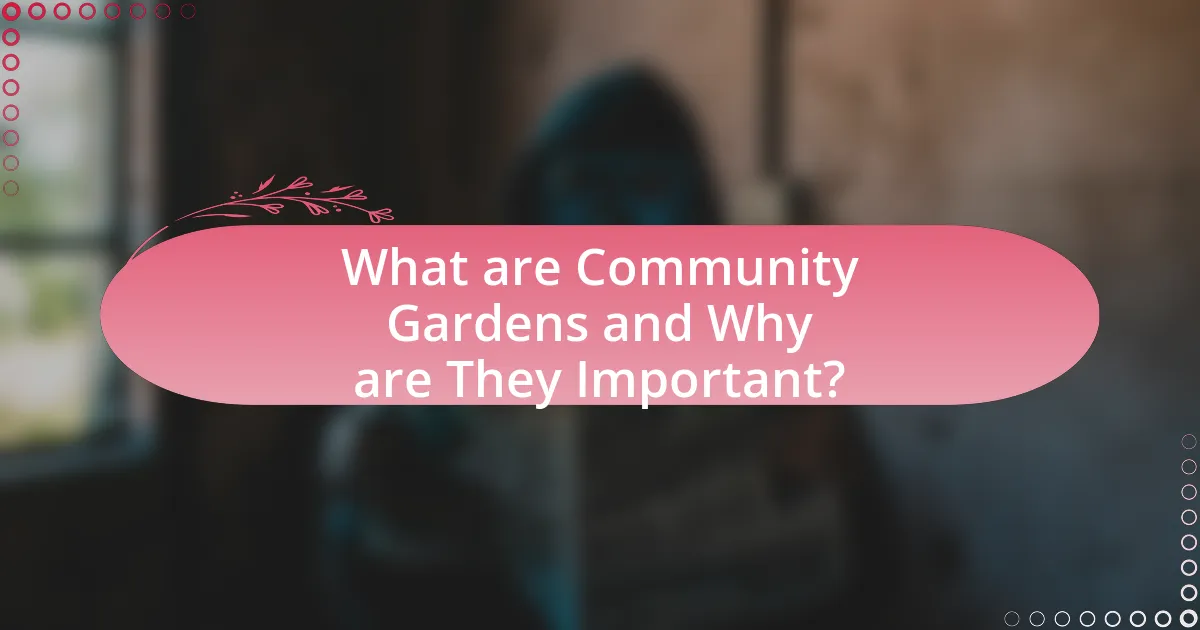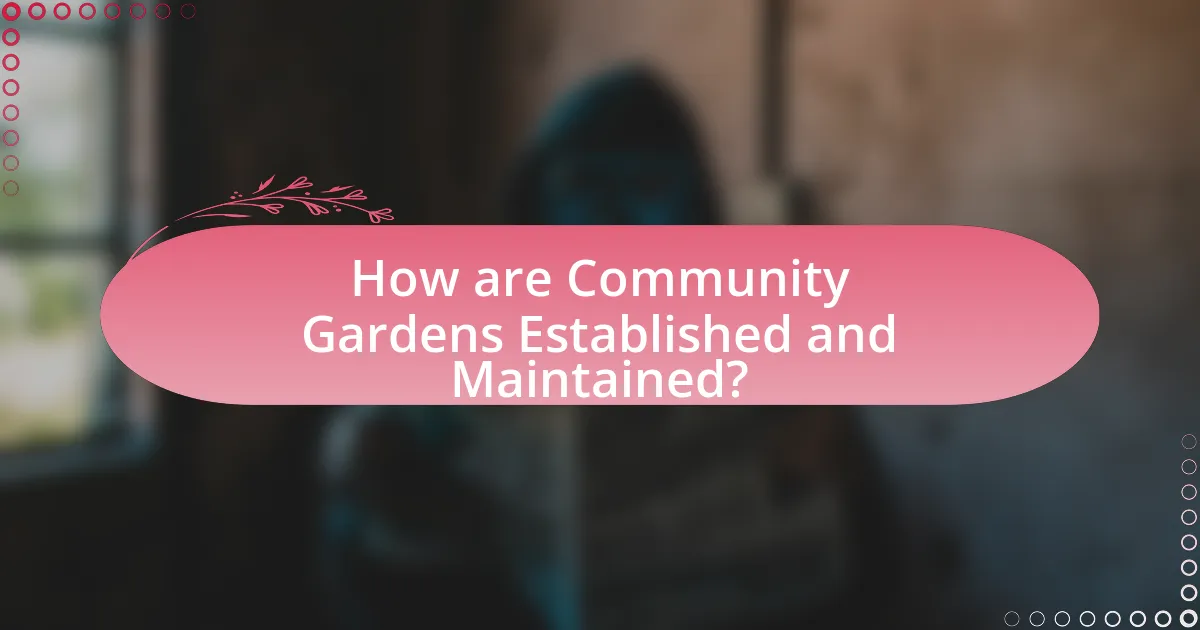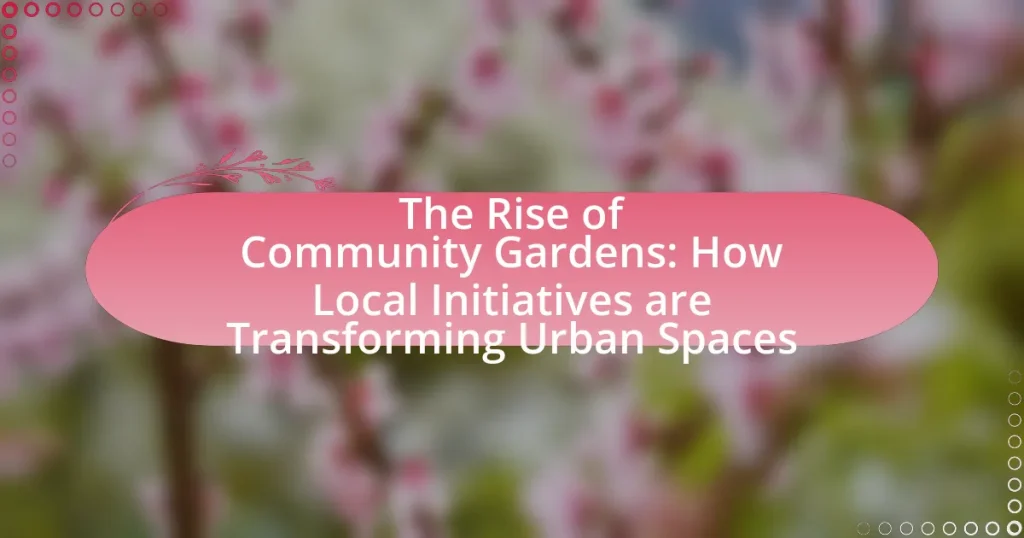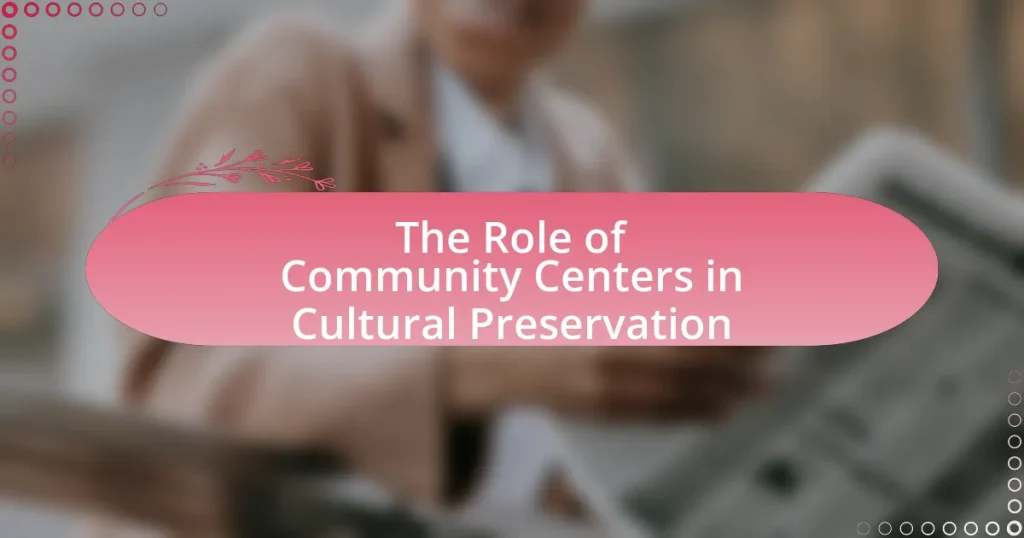Community gardens are shared plots of land cultivated by individuals or groups for food production, education, and community engagement. This article explores the significance of community gardens in urban environments, highlighting their contributions to local food security, biodiversity, air quality, and social cohesion. It examines the economic advantages they offer, such as reduced food costs and increased property values, as well as the challenges they face, including land access and funding. Additionally, the article outlines best practices for establishing and maintaining successful community gardens, emphasizing the importance of community involvement and local initiatives in ensuring their sustainability.

What are Community Gardens and Why are They Important?
Community gardens are shared plots of land where individuals or groups cultivate plants, primarily for food production, education, and community engagement. They are important because they promote local food security, enhance community cohesion, and provide green spaces in urban areas. Research indicates that community gardens can increase access to fresh produce, improve mental health, and foster social interactions among diverse populations, thereby contributing to the overall well-being of communities.
How do Community Gardens contribute to urban environments?
Community gardens contribute to urban environments by enhancing biodiversity, improving air quality, and fostering community engagement. These gardens provide habitats for various species, which increases local biodiversity. Studies show that urban green spaces, including community gardens, can improve air quality by reducing pollutants and increasing oxygen levels. Furthermore, community gardens serve as social hubs, bringing together residents from diverse backgrounds, which strengthens community ties and promotes social cohesion. Research indicates that neighborhoods with community gardens experience lower crime rates and increased community pride, demonstrating their positive impact on urban social dynamics.
What role do they play in enhancing local biodiversity?
Community gardens play a crucial role in enhancing local biodiversity by providing habitats for various species and promoting the growth of diverse plant life. These gardens create green spaces in urban areas, which support pollinators like bees and butterflies, as well as other wildlife. Research indicates that community gardens can increase plant species richness by up to 50% compared to surrounding urban environments, thereby fostering a more diverse ecosystem. Additionally, they often incorporate native plants, which are essential for maintaining local wildlife populations and ecological balance.
How do they improve air quality and reduce urban heat?
Community gardens improve air quality and reduce urban heat by increasing vegetation in urban areas, which enhances carbon dioxide absorption and provides shade. The presence of plants in these gardens helps filter pollutants from the air, leading to cleaner air. Additionally, studies show that urban green spaces can lower surface temperatures by up to 5 degrees Fahrenheit, mitigating the urban heat island effect. This cooling effect is crucial in densely populated areas where heat can exacerbate health issues and energy consumption.
What social benefits do Community Gardens provide?
Community gardens provide significant social benefits, including fostering community engagement, enhancing social cohesion, and promoting inclusivity among diverse populations. These gardens serve as communal spaces where individuals from various backgrounds can collaborate, share knowledge, and build relationships, thereby strengthening community ties. Research indicates that neighborhoods with community gardens experience increased social interaction and a sense of belonging, which can lead to improved mental health and well-being. For instance, a study published in the Journal of Community Psychology found that participants in community gardening reported higher levels of social support and community involvement compared to those not engaged in such activities.
How do they foster community engagement and social cohesion?
Community gardens foster community engagement and social cohesion by providing a shared space for individuals to collaborate on gardening projects, thereby promoting interaction and cooperation among diverse community members. These gardens serve as platforms for social gatherings, workshops, and educational programs, which enhance relationships and build trust within the community. Research indicates that neighborhoods with community gardens experience increased social ties and a sense of belonging, as evidenced by a study published in the Journal of Community Psychology, which found that participants reported higher levels of community involvement and social support after engaging in gardening activities.
What impact do they have on mental health and well-being?
Community gardens positively impact mental health and well-being by fostering social connections and reducing stress. Research indicates that participation in community gardening can lead to lower levels of anxiety and depression, as individuals engage in physical activity and connect with others. A study published in the Journal of Environmental Psychology found that community gardening enhances feelings of belonging and improves overall life satisfaction. Additionally, exposure to green spaces has been linked to improved mood and cognitive function, further supporting the mental health benefits associated with community gardens.
What economic advantages are associated with Community Gardens?
Community gardens provide several economic advantages, including increased access to fresh produce, reduced food costs, and enhanced property values. By growing their own fruits and vegetables, participants can save money on groceries, which is particularly beneficial in urban areas where food prices are high. A study by the American Community Gardening Association found that community gardens can reduce household food expenses by up to 25%. Additionally, the presence of community gardens can lead to a rise in property values in surrounding neighborhoods, as green spaces are often associated with improved aesthetics and community engagement. This increase in property values can contribute to higher tax revenues for local governments, further supporting community development initiatives.
How do they contribute to local food systems and economies?
Community gardens contribute to local food systems and economies by providing fresh produce, enhancing food security, and fostering economic activity within neighborhoods. These gardens increase access to healthy food options, particularly in urban areas where grocery stores may be scarce, thereby improving community health outcomes. According to a study by the American Community Gardening Association, community gardens can yield up to 1,000 pounds of produce per year on a quarter-acre plot, significantly reducing food costs for families. Additionally, they create local jobs and stimulate economic growth by attracting visitors and supporting local businesses through increased foot traffic.
What are the cost-saving benefits for urban residents?
Urban residents benefit from cost savings through community gardens by reducing grocery expenses and enhancing food security. Community gardens provide access to fresh produce, which can lower the cost of purchasing fruits and vegetables. A study by the American Community Gardening Association found that community gardeners save an average of $600 annually on groceries. Additionally, these gardens foster a sense of community, which can lead to shared resources and reduced costs for maintenance and supplies. This collaborative effort further amplifies the financial benefits for urban residents.

How are Community Gardens Established and Maintained?
Community gardens are established through a collaborative process involving local residents, organizations, and government entities. Initially, interested community members identify a suitable plot of land, often vacant or underutilized, and then seek permission from landowners or local authorities to use the space for gardening. This process may include forming a garden committee to organize efforts, create a garden plan, and establish rules for participation.
Maintenance of community gardens relies on the active involvement of participants who share responsibilities such as planting, weeding, watering, and harvesting. Regular meetings help to coordinate activities and address any issues that arise. Additionally, successful community gardens often secure funding or resources through grants, donations, or partnerships with local businesses, which support ongoing maintenance and improvements. Research indicates that community gardens can enhance neighborhood cohesion and provide access to fresh produce, contributing to overall community well-being.
What steps are involved in starting a Community Garden?
To start a community garden, the initial step is to gather a group of interested individuals to form a planning committee. This committee will assess the community’s interest and identify potential locations for the garden. Next, securing land is crucial, which may involve negotiating with local authorities or private landowners for permission to use the space. Following this, the committee should develop a garden plan that outlines the layout, types of plants, and maintenance responsibilities.
Once the plan is established, fundraising or securing resources is necessary to cover costs for tools, seeds, and soil. After funding is in place, the community can organize a garden installation day, where volunteers come together to prepare the site and plant the garden. Finally, establishing a schedule for ongoing maintenance and community engagement activities ensures the garden remains productive and fosters a sense of community.
How do communities identify suitable locations for gardens?
Communities identify suitable locations for gardens by assessing factors such as sunlight exposure, soil quality, water access, and proximity to community members. For instance, areas that receive at least six hours of sunlight daily are preferred, as this is essential for plant growth. Soil testing is often conducted to ensure it is free from contaminants and has the necessary nutrients for gardening. Additionally, access to water sources is critical, as gardens require consistent irrigation. Proximity to community members enhances participation and maintenance, making locations within walking distance more desirable. These criteria are supported by studies indicating that successful community gardens thrive in environments that meet these specific conditions, thereby fostering sustainable urban agriculture.
What resources are necessary for initial setup and ongoing maintenance?
Initial setup of community gardens requires land access, soil, seeds or plants, tools, and water supply. Ongoing maintenance necessitates labor for weeding, watering, harvesting, and pest control, as well as community engagement for volunteer support. Research indicates that community gardens can improve local food security and foster social connections, highlighting their importance in urban spaces.
How do local initiatives support the sustainability of Community Gardens?
Local initiatives support the sustainability of community gardens by providing resources, fostering community engagement, and promoting environmental education. These initiatives often include funding opportunities, access to land, and tools that help maintain the gardens. For example, programs like the Community Garden Grant Program in various cities allocate funds specifically for the development and upkeep of community gardens, ensuring they have the financial backing needed to thrive. Additionally, local organizations often facilitate workshops and events that encourage community participation, which strengthens social ties and increases volunteer involvement. Research indicates that community gardens with strong local support networks are more likely to succeed and endure over time, as evidenced by studies showing that gardens with active community involvement have higher rates of sustainability and productivity.
What role do local governments play in supporting these initiatives?
Local governments play a crucial role in supporting community garden initiatives by providing resources, policy frameworks, and facilitating community engagement. They often allocate funding for garden projects, offer land access through leases or grants, and implement zoning regulations that favor urban agriculture. For instance, cities like San Francisco have established programs that provide technical assistance and financial support to community gardens, demonstrating the effectiveness of local government involvement in enhancing urban green spaces.
How can community members ensure long-term success?
Community members can ensure long-term success by actively participating in the planning, maintenance, and governance of community gardens. Engaging in regular meetings fosters collaboration and shared decision-making, which strengthens community bonds and commitment. Research indicates that community gardens with strong member involvement are more sustainable; for instance, a study published in the Journal of Community Practice found that gardens with active participation saw a 30% increase in productivity and community engagement over five years. This demonstrates that consistent involvement and shared responsibility are critical for the longevity and effectiveness of community gardening initiatives.

What Challenges Do Community Gardens Face?
Community gardens face several challenges, including land access, funding, and community engagement. Limited access to suitable land often results from zoning laws and competition with developers, making it difficult for community members to establish gardens. Additionally, securing funding for resources such as seeds, tools, and maintenance can be a significant hurdle, as many gardens rely on grants or donations that may not be consistently available. Furthermore, sustaining community engagement is crucial; without active participation from local residents, gardens can struggle to thrive and meet their intended goals. These challenges highlight the complexities involved in maintaining community gardens and the need for ongoing support and collaboration among stakeholders.
What common obstacles hinder the development of Community Gardens?
Common obstacles that hinder the development of community gardens include lack of funding, insufficient land access, and community engagement challenges. Funding is often limited, making it difficult to secure resources for garden establishment and maintenance. Additionally, access to suitable land can be a significant barrier, as many urban areas have zoning regulations that restrict gardening activities. Furthermore, engaging the community can be challenging due to varying levels of interest and commitment among residents, which can lead to difficulties in organizing and sustaining the garden efforts. These factors collectively impede the successful establishment and growth of community gardens.
How do zoning laws and regulations impact garden establishment?
Zoning laws and regulations significantly impact garden establishment by dictating where gardens can be located and what types of gardening activities are permissible. These laws can restrict the use of land for gardening purposes, often designating specific zones for residential, commercial, or agricultural use. For instance, in urban areas, zoning regulations may limit community gardens to certain districts, thereby influencing their accessibility and viability. Additionally, regulations may impose requirements such as setbacks, height restrictions, or the need for permits, which can complicate the establishment process. Research indicates that cities with supportive zoning policies, such as those that allow for urban agriculture, tend to have a higher number of community gardens, demonstrating a direct correlation between zoning flexibility and garden proliferation.
What are the challenges related to funding and resource allocation?
The challenges related to funding and resource allocation for community gardens include limited financial resources, competition for grants, and inconsistent funding sources. Community gardens often rely on donations, grants, and local government support, which can be unpredictable. For instance, a study by the American Community Gardening Association found that many community gardens struggle to secure long-term funding, leading to project instability. Additionally, the competition for available grants can be fierce, as multiple initiatives vie for the same limited pool of resources, making it difficult for community gardens to sustain operations and expand.
How can communities overcome these challenges?
Communities can overcome challenges related to the establishment and maintenance of community gardens by fostering collaboration among residents, local governments, and organizations. This collaboration can lead to shared resources, such as funding, tools, and expertise, which are essential for successful garden projects. For instance, a study by the American Community Gardening Association found that community gardens can increase neighborhood cohesion and provide access to fresh produce, thereby addressing food insecurity. Additionally, implementing educational programs about gardening techniques and sustainable practices can empower community members, ensuring the longevity and productivity of these gardens.
What strategies can be implemented to advocate for supportive policies?
To advocate for supportive policies for community gardens, stakeholders can implement strategies such as building coalitions, engaging in public education, and leveraging data to demonstrate benefits. Building coalitions among community members, local organizations, and policymakers fosters a united front that amplifies advocacy efforts. Public education campaigns can raise awareness about the environmental, social, and economic benefits of community gardens, such as improved food security and community cohesion. Additionally, presenting data from studies, like the one conducted by the American Community Gardening Association, which shows that community gardens can increase property values and reduce crime rates, provides concrete evidence to support policy changes.
How can community members collaborate to secure funding and resources?
Community members can collaborate to secure funding and resources by forming partnerships with local organizations, applying for grants, and organizing fundraising events. Collaborative efforts, such as creating a community garden committee, enable members to pool their skills and resources, increasing their chances of successfully obtaining financial support. For instance, community gardens that have partnered with local nonprofits have reported higher success rates in grant applications, as these organizations often have established relationships with funding bodies and can provide guidance on proposal writing. Additionally, organizing events like plant sales or community potlucks can raise funds while fostering community engagement, which is essential for sustaining long-term projects.
What are the Best Practices for Successful Community Gardens?
Successful community gardens require clear organization, community involvement, and sustainable practices. Establishing a strong governance structure, such as a garden committee, ensures effective decision-making and conflict resolution. Engaging local residents in planning and maintenance fosters ownership and commitment, which are crucial for long-term success. Implementing sustainable gardening techniques, such as composting and organic pest control, enhances soil health and promotes biodiversity. Research indicates that community gardens can improve neighborhood cohesion and provide access to fresh produce, contributing to overall community well-being. For instance, a study published in the Journal of Community Health found that community gardens significantly increase fruit and vegetable consumption among participants.
How can individuals get involved in their local Community Gardens?
Individuals can get involved in their local Community Gardens by participating in volunteer days, joining gardening clubs, or attending community meetings. Many Community Gardens organize regular volunteer events where individuals can help with planting, weeding, and maintenance, fostering a sense of community and shared responsibility. Joining local gardening clubs or organizations can provide additional opportunities for involvement, as these groups often collaborate with Community Gardens for events and educational workshops. Additionally, attending community meetings allows individuals to stay informed about garden activities and contribute ideas for improvement or new projects.











![Behind the Scenes of [City]’s Community Theater Productions](https://carthagestandard.com/wp-content/uploads/Featured-image-Behind-the-Scenes-of-Citys-Community-Theater-Productions-150x150.webp)



